Genomics of Three New Bacteriophages Useful in the Biocontrol of Salmonella
- PMID: 27148229
- PMCID: PMC4837284
- DOI: 10.3389/fmicb.2016.00545
Genomics of Three New Bacteriophages Useful in the Biocontrol of Salmonella
Abstract
Non-typhoid Salmonella is the principal pathogen related to food-borne diseases throughout the world. Widespread antibiotic resistance has adversely affected human health and has encouraged the search for alternative antimicrobial agents. The advances in bacteriophage therapy highlight their use in controlling a broad spectrum of food-borne pathogens. One requirement for the use of bacteriophages as antibacterials is the characterization of their genomes. In this work, complete genome sequencing and molecular analyses were carried out for three new virulent Salmonella-specific bacteriophages (UAB_Phi20, UAB_Phi78, and UAB_Phi87) able to infect a broad range of Salmonella strains. Sequence analysis of the genomes of UAB_Phi20, UAB_Phi78, and UAB_Phi87 bacteriophages did not evidence the presence of known virulence-associated and antibiotic resistance genes, and potential immunoreactive food allergens. The UAB_Phi20 genome comprised 41,809 base pairs with 80 open reading frames (ORFs); 24 of them with assigned function. Genome sequence showed a high homology of UAB_Phi20 with Salmonella bacteriophage P22 and other P22likeviruses genus of the Podoviridae family, including ST64T and ST104. The DNA of UAB_Phi78 contained 44,110 bp including direct terminal repeats (DTR) of 179 bp and 58 putative ORFs were predicted and 20 were assigned function. This bacteriophage was assigned to the SP6likeviruses genus of the Podoviridae family based on its high similarity not only with SP6 but also with the K1-5, K1E, and K1F bacteriophages, all of which infect Escherichia coli. The UAB_Phi87 genome sequence consisted of 87,669 bp with terminal direct repeats of 608 bp; although 148 ORFs were identified, putative functions could be assigned to only 29 of them. Sequence comparisons revealed the mosaic structure of UAB_Phi87 and its high similarity with bacteriophages Felix O1 and wV8 of E. coli with respect to genetic content and functional organization. Phylogenetic analysis of large terminase subunits confirms their packaging strategies and grouping to the different phage genus type. All these studies are necessary for the development and the use of an efficient cocktail with commercial applications in bacteriophage therapy against Salmonella.
Keywords: Myoviridae; Podoviridae; Salmonella; bacteriophage; chromosomal ends; genomics.
Figures







References
-
- Bardina C. (2011). Estudio Sobre Terapia Fágica Contra S. enterica en Gallus gallus. Dissertation/master's thesis, Universitat Autònoma de Barcelona.
LinkOut - more resources
Full Text Sources
Other Literature Sources
Research Materials

